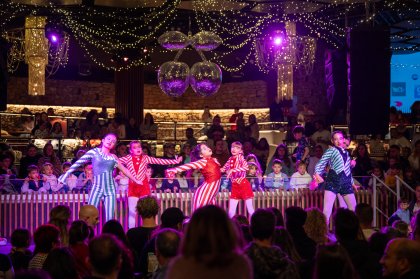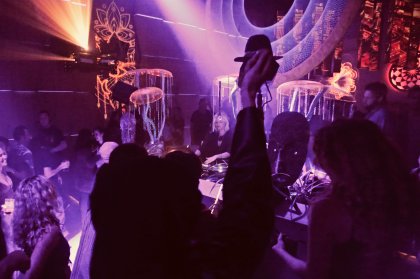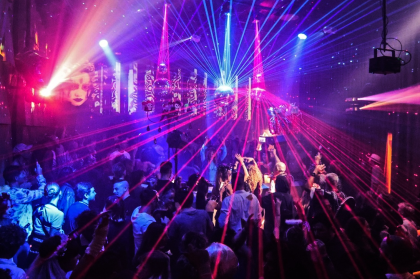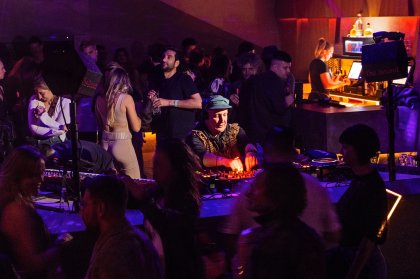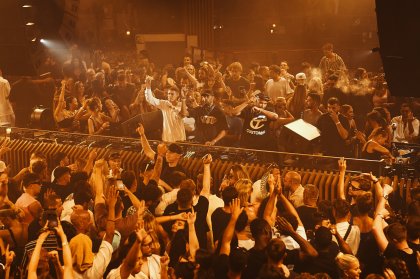
It's 1991, and, far from what the middle classes hoped, England's latest revolution isn't disintegrating. In fact, it's getting bigger by the day.
Acid house, rave, techno, electro… whatever the particular wording, it's been burgeoning across a nation now riddled by recession since arriving from the US and a certain Balearic island. From London's M25 orbital motorway, and the raves it inspired in the surrounding rural areas, to the northern parties that saw industrial sites reclaimed and put to good use, a generation woke the nation with fast repetitive music.
On September 21st a former bus depot near Elephant & Castle Tube Station, south London, opened as a new, alcohol free nightclub. The first to be dedicated to this new dance music, with a purpose built dancefloor and soundsystem designed for four four, specifically house, beats. Ministry of Sound was born, and with it James Palumbo, Justin Berkmann and Humphrey Waterhouse's vision of bringing those underground sessions into clubs, and under license, had been realised.
Needless to say, it wasn't long before the country and continent were looking on as this new club, styled on New York's infamous Paradise Garage, began forging its own inimitable reputation- and not just for the quality of the speakers. Two years after opening a new resident arrived, bringing a globally recognised face and Big Apple attitude to the Big Smoke. Enter the legendary Tony Humphries, followed by Sessions Vol.1, and a fresh chapter in the story.

The legendary 'Box' room in 1991. (prize for whoever can guess the DJ)
Spanning raw, funk-fuelled house through to early, drum heavy prog, with its first compilation Ministry' gave us all a sign of (many) things to come. The series would go on to boast instalments from Paul Oakenfold, Todd Terry, CJ Mackintosh, Frankie Knuckles and Masters At Work to name but a few. A lengthy list, though one that pales in comparison to the overall archives of the world's largest independent record label.
So that was then, whereas this is now. In between we've seen other seminal additions to the label stable, and not just in the shape of albums such as 1995's The Annual, Northern Exposure from Sasha & John Digweed, or singles like When The Freaks Come Out from Cevin Fisher's Big Freak. And we've had parties, almost too many to count- from those early, heady backstreet affairs to Ibiza in the summer, and a Millennium Dome rammed to the rafters with ravers.
Ministry's Biggest Selling Album
Times have certainly changed. This goliath of clubland has lived up to its name. Because Ministry' isn't just a night, a venue and an imprint, it's all and then some. Boasting, at various points, a magazine, clothing line, DJ equipment range and more, it has been accused of overkill. This company that now employs hundreds was, after all, supposed to be about a party.
Palumbo is a man with a stern reputation in the business world. An Eton alumni, and entrepreneur in extremis, it's clear that the corporate acumen for which he is known has been the driving force behind the brand's global dominance of dance. And even purists must show some respect to someone who turned a room full of eye-rolling 20-somethings into a business with annual sales approaching £100million.
A remarkable story, no matter which side of the fence you fall on. Dance music can never be the same as when the world was hurtling, at pace, towards the hedonism of New Year's Eve 1999. The words main room no longer mean a 1,500 strong crowd each weekend, and small clubs are back in a big way. With that in mind it's all the more impressive that Ministry' has, in one way or another, stayed on top of its game, the first, and one of the last in a dying breed of British superclub brands.
Ministry of Sound 20:20 Project
(Press Release)
2011 is a significant milestone in Ministry of Sound's continuing evolution marking the 20th anniversary of the South London venue opening its doors as an alcohol-free nightclub dedicated to house music on 21st September 1991 (the former bus depot at 103 Gaunt Street remains the beating heart of the company's worldwide operations).
To celebrate 20 years at the forefront of modern youth culture, Ministry of Sound has announced the 20:20 Project, an extensive range of activity throughout 2011 which includes a free month-long exhibition, a 3 day party celebrating the birthday at the London venue in September, a 20 date international tour, a fully searchable online timeline of the club over past 20 years and much more.
The 20:20 Project launches on 4th March with a free daytime exhibition and multi-media experience at the club, bringing to life the evolution of youth culture and dance music over the past 20 years. Showcasing a unique archive of photography, design, and featuring contributions from some of the biggest names in dance music, the exhibition is a must for anyone interested in youth culture, electronic music and the future of late night London.
A year-by-year montage of iconic images (many unseen and sourced from DJs, promoters, and photographers) of the past two decades, with accompanying commentary provided by key individuals and DJs who were intrinsic to the club's creation and development.
In association with Martin Audio, the company responsible for the club's infamous customised soundsytem, the exhibition also highlights Ministry of Sound's position as one of the leading pioneers of audio technology, with a multi-media installation in The Box (the club's main room) which features a range of artifact displays and a 5.5 metre LED wall made by Martin.
Ministry of Sound is also offering visitors the chance to play a track on the club's system and experience what it feels like to stand in the legendary DJ booth in the shoes of Pete Tong, David Guetta, Roger Sanchez, Larry Levan, Sasha and the rest of the world's superstar DJs, accompanied by projections, CO2 cannons and sound effects to recreate Saturday night headline slots.
The club's Baby Box room will be returned to its original incarnation as a cinema, with two short films about Ministry of Sound's history, featuring interviews with leading clubland figures from the past two decades. The exhibition runs until 1st April.
The wider calendar of 20:20 Project activity, including details of the birthday weekend celebration in September, international tour events, album releases, and more, will be announced in due course.
Ministry of Sound Group Managing Director Iain Hagger said:
“There is no better way to experience the essence of Ministry of Sound than by standing in the club's main room (The Box) in the middle of the towering speaker stacks and triple thick sound absorbing walls listening to the world's greatest DJ's play the world's best music on the world's best soundsystem. 20 years on and excellence in sound is still what we stand for. The 20:20 Project celebrates our history but also looks forward - the new music, talent and technology that will shape dance music for the next 20 years - and the role that we'll continue to play in creating those euphoric hands-in-the-air moments.”
LISTINGS INFORMATION:
20:20 EXHIBITION
1991 – 2011 – 2031
The blueprint for club culture, past, present & future.
Opening 3rd March - a free in-club exhibition of unseen photography, iconic artwork, documentary footage and bespoke audio visual installations
4th March – 1st April at Ministry of Sound
103 Gaunt Street
SE1 6DP
London
Tuesday to Friday 12–7pm
Late night opening ‘til 9pm every Thursday.
Admission free
Nearest Underground Station: Elephant & Castle
